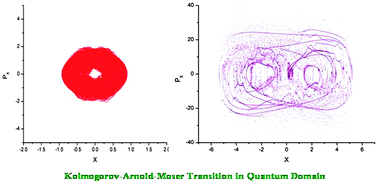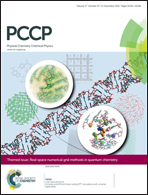Orbital free DFT versus single density equation: a perspective through quantum domain behavior of a classically chaotic system†
Abstract
The orbital free density functional theory and the single density equation approach are formally equivalent. An orbital free density based quantum dynamical strategy is used to study the quantum-classical correspondence in both weakly and strongly coupled van der Pol and Duffing oscillators in the presence of an external electric field in one dimension. The resulting quantum hydrodynamic equations of motion are solved through an implicit Euler type real space method involving a moving weighted least square technique. The Lagrangian framework used here allows the numerical grid points to follow the wave packet trajectory. The associated classical equations of motion are solved using a sixth order Runge–Kutta method and the Ehrenfest dynamics is followed through the solution of the time dependent Schrodinger equation using a time dependent Fourier Grid Hamiltonian technique. Various diagnostics reveal a close parallelism between classical regular as well as chaotic dynamics and that obtained from the Bohmian mechanics.

- This article is part of the themed collection: Real-space numerical grid methods in quantum chemistry

 Please wait while we load your content...
Please wait while we load your content...